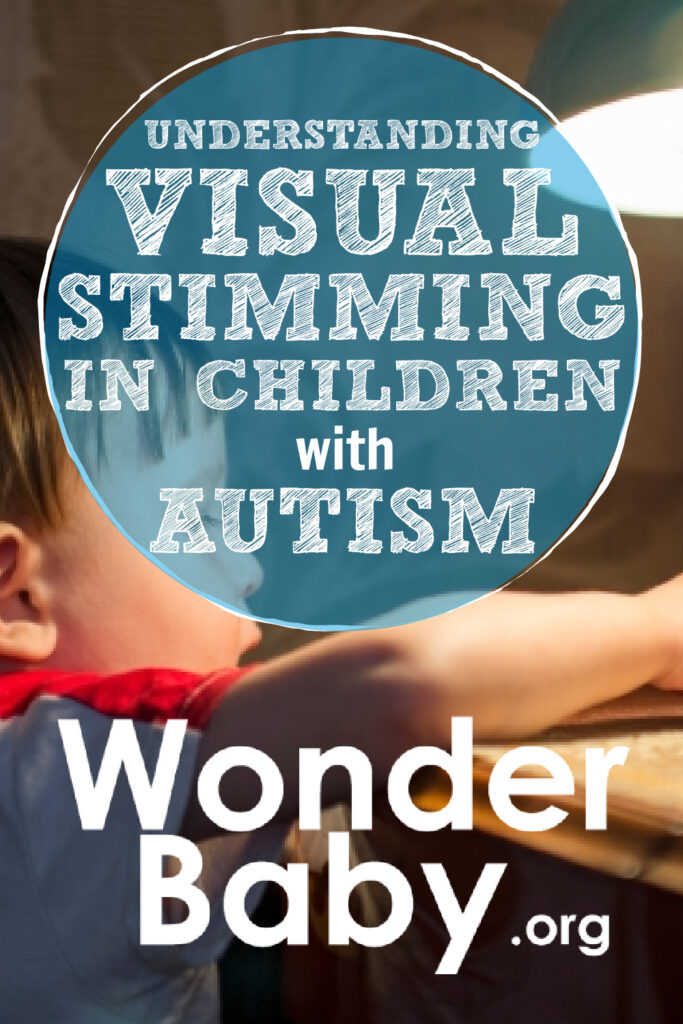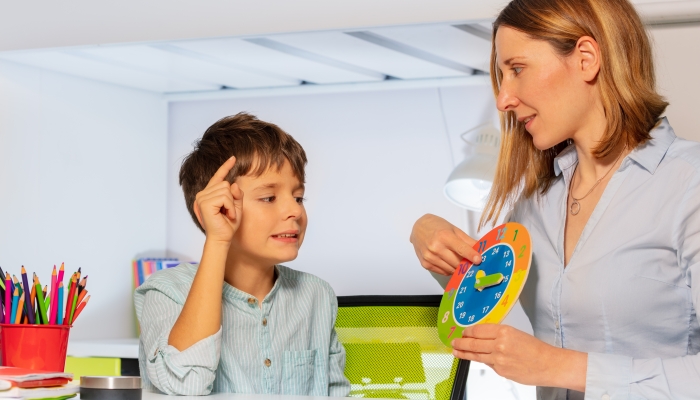Understanding Visual Stimming in Children with Autism

- Visual stimming is one form of repetitive behavior that autistic children use to self-soothe.
- Not all types of visual stimming are socially unacceptable.
- There are several techniques you can try to help reduce visual stimming.
Stimming is a term often associated with autism spectrum disorder and other sensory processing disorders. But stimming behaviors are common for most of us at one time or another.
Performing repetitive movements and noises that soothe anxiety during challenging situations can be considered stimming behaviors. These sensory-pleasing habits can be either visual, auditory, tactile, oral, vestibular, or verbal.
The following are common stimming behaviors when done repeatedly:
- Finger tapping
- Cracking knuckles
- Head banging
- Staring at moving objects or lights
- Rocking/twirling
- Grunting
- Licking
As you can see, some repetitive behaviors such as cracking knuckles are quite common and not really considered unusual. People generally can stop the behavior if they’re told it’s annoying.
But autistic children often have a more difficult time controlling repetitive behaviors. At times, these mannerisms can be disruptive, socially unacceptable, or harmful (such as in the case of head banging).
This article will focus on visual stimming to help you better understand the causes, what it looks like, and effective ways to manage this challenging behavior.
Visual Stimming: What Is It?
Visual stimming is self-soothing, repetitive behavior that involves the eyes or eyesight.
Examples of visual stimming behaviors include the following, when done repeatedly:
- Rapid eye blinking
- Staring at moving ceiling fans
- Looking out of the side of the eye
- Staring at blinking or other types of lights
- Squeezing eyes tightly shut
- Lining up objects to look at
- Turning lights off and on
- Moving fingers in front of eyes
Often, autistic children display at least one of these visual stimming mannerisms to calm their senses.

What Causes Visual Stimming Behavior?
Stimming, including visual stimming, is an adaptive behavior used for comfort or self-soothing. Medical professionals and family members aren’t usually concerned about this behavior unless it’s self-destructive or begins to interfere with the person’s or others’ daily life.
According to one study on autistic adults’ views of stimming, “Autistic adults highlighted the importance of stimming as an adaptive mechanism that helps them to soothe or communicate intense emotions or thoughts.”
Autistic individuals may choose visual stimming as a way to calm visual input. Each person may have a different preference for their stim of choice, and these sensory mannerisms can change throughout their life or even disappear altogether.
No matter what the preferred stim looks like, when sensory overload hits, autistic children often employ whatever repetitive behaviors feel best to cope.
At times, stims related to eyes can be confused with tics. The difference between tics versus stimming lies in the reason why children execute these behaviors. Tics are not self-soothing but are instead a powerful urge to perform repetitive body movements or sounds. Stimming, on the other hand, refers to repetitive mannerisms used exclusively to soothe an individual.
Besides soothing when overstimulated, other reasons for stimming may be:
- Enjoyment
- Managing emotions such as anger or fear
- Stimulating oneself when bored or understimulated
- Communication
- Easing discomfort
Does Visual Stimming Always Indicate Autism?
Although the CDC includes stimming as part of the diagnostic criteria for autism, visual stimming isn’t always indicative of this disorder.
As specified earlier, visual stimming can be a common trait and isn’t a concern unless it begins to interfere with daily life. While some stimming behaviors such as hair twirling can be an annoying habit, being able to control and stop the repetitive mannerism makes it less concerning.
There are also some other medical and behavioral conditions associated with visual stimming besides autism. Stimming, including visual behaviors, is not uncommon for a child with ADHD. Medical professionals attribute this repetitive behavior in ADHD to a desire for activity in a child who requires frequent movement.
Other conditions associated with visual stimming may be:
- Allergies (specifically seasonal)
- Vision deficiencies or conditions
- Anxiety
Children with Tourette Disorder may also appear to use stimming behaviors, but these mannerisms—while similar—are typically involuntary tics as opposed to a source of comfort.

Visual Stimming in Children with Autism
It’s well-known that stimming behaviors are associated with children with autism spectrum disorder. That includes repetitive eye mannerisms for soothing, such as staring at objects and moving fingers in front of the eyes.
Any type of stimming behavior is part of the diagnosis (DSM-5) criteria for children with suspected autism. Although stimming is often typical for the general population, autism stimming takes the behavior to another level.
Depending on the intensity, difficulty in controlling these mannerisms, and certain socially unacceptable stimming behaviors (such as turning lights off and on in a classroom), visual and other stimming behaviors may be caused by autism in children.
Your autistic child may stim more frequently when experiencing a new environment such as preschool or school.
Each time there is a change, such as a new teacher, a new routine, or a disruptive child in the classroom, your child may feel scared, out of control, or overstimulated. Thus, repetitive visual behaviors along with other stimming habits may increase.
Often an autistic child may appear out of control as stimming increases in these situations. But the end result can hopefully be a calmer child that can settle back into the daily routine.
As a school nurse, I would often be called into a special needs classroom to check on a child with autism experiencing a sensory meltdown.
Once the screaming and headbanging subsided, the child would often switch to a more subdued self-soothing ritual such as visual stimming with their fingers floating in front of their eyes or staring at the rotating ceiling fans.
This repetitive calming measure helped the upset child to once again transition back into class and get on with their school day.
Tips to Manage Visual Stimming in Autistic Children
There are differing opinions on whether or not it’s beneficial to try to eliminate stimming behaviors in the autistic population. Since stims are employed as a self-soothing measure, many autistic people and their parents question the need to manage this behavior.
However, most agree that stimming that is socially unacceptable, self-destructive, and interferes with others should be redirected.
A medical professional experienced in treating kids with autism can provide guidance and support for a parent who needs help managing their child’s visual stimming behavior.
Fortunately, much literature on stimming management is available, as well as parent support groups that can help in this area.
Techniques and ideas to ease the urge for visual stimming in autistic kids can include:
- Provide a sensory room. Try moving a child who may have trouble dealing with an overstimulating environment to a calmer sensory room. This can help them to decompress.
- Consider a sensory swing. If you don’t have the space for a sensory room, a sensory swing will be one of your most helpful tools. The calming motion of sensory swings can soothe even the most agitated child.
- Encourage your child to verbalize their concerns when displaying visual stimming behavior.
- Avoid trigger sources. Once you identify what triggers anxiety and stimming behavior, explore ways to avoid it.
- Learn redirection strategies. Most children have favorite stims, but you can introduce other less offensive self-soothing behavior such as wearing sunglasses or noise-canceling headphones to reduce offending stimuli. Sensory toys and lights are also effective tools for redirecting stimming behavior.
- Try speech therapy. Some children cannot verbalize what’s bothering them. A speech therapist can help teach an autistic child to use short phrases when in distress, such as “too bright,” which can make communication more clear.
- Incorporate frequent short exercise sessions throughout the day. Studies show multiple benefits of exercise for children with autism, including socialization.
- Schedule stim breaks. Some parents report that scheduled breaks to stim can help a child self-soothe at socially acceptable times.
Why Managing Visual Stimming is Beneficial
Whether your child chooses visual stimming to self-soothe or employs other types of repetitive calming mannerisms, stims can easily escalate, get out of control, embarrass the child, or cause harm to themselves or others.
Accepting professional guidance and having management strategies on hand will help parents to guide their autistic child to more socially accepted techniques that are less extreme and easier for outsiders to tolerate.

The information WonderBaby provides is not intended to be, and does not constitute, medical or other health advice or diagnosis and should not be used as such. Always consult with a qualified medical professional about your specific circumstances.
Related Posts

Autism
Developing Time Management Skills in Children with Autism: 7 Tips
Learn how you can use structure and visual aids to help your child with autism learn time management skills.

Autism
Occupational Therapy for Children with Autism: How It Can Make a Difference
Children with autism face challenges in many different areas. Occupational therapy can help children address these difficulties while having fun!

Autism, Behavior
OCD vs Autism in Children: How To Tell the Difference
OCD and ASD are fundamentally different, but their symptoms are very similar. Learn how to tell the difference to support your child.